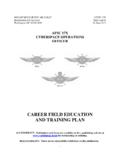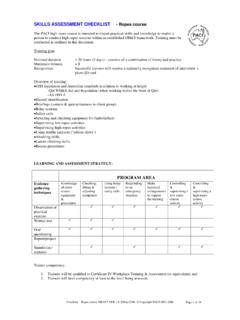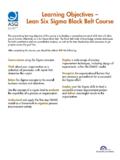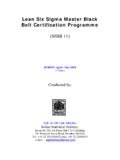Transcription of WHAT ROLE CAN A TRAINING NEEDS ANALYSIS …
1 WHAT ROLE CAN A TRAINING NEEDS ANALYSIS PLAY IN ORGANISATIONAL CHANGE? MSc in TRAINING and human resource management 2003 Jacqueline Reed Abstract This research set out to examine how the process for developing a TRAINING NEEDS ANALYSIS tool could influence organisational change. In addition consideration was given to how the TRAINING NEEDS ANALYSIS process can help get people on board with organisational change and be a change intervention in itself. The organisation that is the subject of this research is a large, complex health system which is in transition from a traditional bureaucratic, hierarchy with a command and control management style to a more participative, people centred approach. The organisation is operating in an environment of almost constant change with major national restructuring of the health services expected imminently.
2 A processual, organisation development, action research based approach to the development of a TRAINING NEEDS ANALYSIS process was taken in the study so that the changes desired in the organisation could be modelled in the first instance and secondly, in order to learn and understand more about what works and does not in order to continuously develop and progress the change agenda. In order to do this a parallel structure was established through which to progress the process which was tracked in an action research process. In addition, a series of interviews were conducted with top and senior management in order to ascertain their views about the process, its necessity, roles in relation to it, its potential benefits and how to introduce the process across the organisation.
3 The research is reported in the format of an action research approach case study. The term learning and development NEEDS ANALYSIS was adopted during the course of the study rather than TRAINING NEEDS ANALYSIS . This was part of a strategy to broaden the focus of TRAINING and development in the organisation beyond the traditional TRAINING course. The action research approach used in this research helped to highlight the significant impact the dynamics of hierarchy and the legacy of a bureaucratic, autocratic system has on the way a system operates and how people react to change and participation. A number of key points emerged from the research: 1. The culture and change issues arising during the development of the learning and development NEEDS ANALYSIS process were very significant. 2. The development and piloting of the NEEDS ANALYSIS process needed to be approached as a change management process.
4 3. Linking the NEEDS ANALYSIS process with existing organisational processes was a key factor in the success of the process and created a strategic dimension. 4. In a large, complex organisation a balance must be struck between standardisation and customisation of the NEEDS ANALYSIS process to allow for the different structures, subcultures and levels of readiness in the organisation. Key words: TRAINING NEEDS ANALYSIS , organisational change, organisational development, public service. 2 Contents Introduction 5 Literature Review 11 TRAINING NEEDS ANALYSIS 11 Shift to human resource Development 21 Examples of TNA processes 23 Organisational change 27 Reasons for resistance to change 32 Organisational learning and change 37
5 Change management in the public sector 40 Parallel structures as a mechanism for change 43 Theory of permeability of system boundaries 45 Methodology 47 The participants 48 The process 49 The interviews 51 Preparation and ANALYSIS of data 52 Research design 54 Results 55 Entry and Contracting 57 Diagnosis 60 Planning 68 Action 72 Evaluation 77 Findings from interviews 83
6 Discussion and conclusions 92 References 99 Bibliography 109 Appendices 119 i) Interview schedule 119 ii) Sample minutes 120 iii) Evaluation questionnaire 126 Introduction The conduct of a TRAINING NEEDS ANALYSIS is generally recognised in the literature as the first step in any professional approach to TRAINING .
7 It is the foundation or starting point for any successful TRAINING intervention and is taken as the norm. However, despite the seemingly universal agreement that a thorough TRAINING NEEDS ANALYSIS should underpin all TRAINING plans and budgets the literature also acknowledges that it does not often take place and is often not done in organisations. Furthermore, there appears to be no research as to why this may be the case. Much of the literature on TRAINING NEEDS ANALYSIS focuses on various methodologies or approaches that may be taken. Some acknowledgement is made of the fact that a TRAINING NEEDS ANALYSIS as outlined in the systematic approach to TRAINING is in fact, time consuming and costly particularly if conducted on an organisation wide basis. In the literature a number of different terms are encountered in this area with similar and differing meanings depending on the author.
8 Identification of TRAINING NEEDS , TRAINING NEEDS assessment, TRAINING NEEDS ANALYSIS are all terms found in the literature. For the purposes of this study the term TRAINING NEEDS ANALYSIS will be used and taken to mean the process of gathering, assessing and analysing data to determine the TRAINING NEEDS for an organisation. Later on in this study, the term Learning and Development NEEDS ANALYSIS has been adopted, although this term is not generally found in the literature. This term was decided upon within the organisation that is the subject of this study. It was deliberately chosen as part of a 5strategy, to broaden the focus of TRAINING and development in the organisation beyond the traditional TRAINING courses. Within the organisation, there is a predominant tendency to think of TRAINING in terms of courses only and this has been reinforced through the role played to date by the TRAINING function.
9 Much of the literature around TRAINING NEEDS ANALYSIS focuses on specific NEEDS ANALYSIS for specific organisational purposes. There is general agreement that TRAINING NEEDS ANALYSIS should take place at the level of the organisation, the job or group and the individual. Again however, there is little in the literature relating to the conduct of an organisation wide TRAINING NEEDS ANALYSIS in a large complex organisation, for the purposes of determining the overall and specific area TRAINING need, in order to develop appropriate plans, which enable the provision of the learning opportunities required to achieve the goals of the organisation (Boydell and Leary 1996). Furthermore, there is little if any consideration given to change issues which may arise in introducing a TRAINING NEEDS ANALYSIS process in an organisation.
10 A number of texts (Boydell and Leary, Garavan et al., 1995 and Reid and Barrington 1999) mention the sensitivity required and the fact that people can be sensitive about TRAINING NEEDS ANALYSIS , particularly as it can highlight areas of deficit. Research by Anderson (1994) and Holton et al., (2000) both address TRAINING NEEDS ANALYSIS in terms of a change process. Anderson (1994) proposes an action research based approach, viewing TRAINING NEEDS ANALYSIS as a systems intervention and Holton et al., (2000) attempt a large scale TRAINING NEEDS ANALYSIS process. Holton et al., (2000) noted that compromises had to be made in terms of choices re TRAINING NEEDS 6analysis to accommodate change and cultural issues. None of the literature addresses the concept, that conducting a TRAINING NEEDS ANALYSIS in itself could have any impact or role in overall organisational change.








